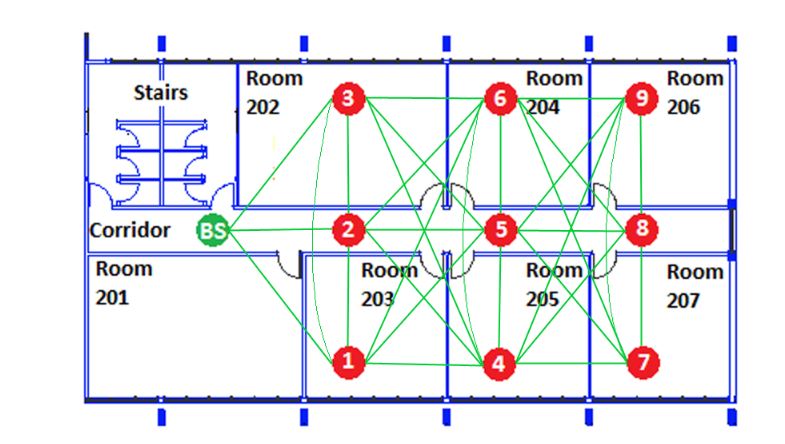ABSTRACT
The Internet of Things (IoT) is attracting considerable attention from the universities, industries, citizens and governments for applications, such as healthcare, environmental monitoring and smart buildings. IoT enables network connectivity between smart devices at all times, everywhere, and about everything. In this context, Wireless Sensor Networks(WSNs) play an important role in increasing the ubiquity of networks with smart devices that are low-cost and easy to deploy. However, sensor nodes are restricted in terms of energy, processing and memory.
Additionally, low-power radios are very sensitive to noise, interference and multipath distortions. In this context, this article proposes a routing protocol based on Routing by Energy and Link quality (REL) for IoT applications. To increase reliability and energy-efficiency, REL selects routes on the basis of a proposed end-to-end link quality estimator mechanism, residual energy and hop count. Furthermore, REL proposes an event-driven mechanism to provide load balancing and avoid the premature energy depletion of nodes/networks. Performance evaluations were carried out using simulation and testbed experiments to show the impact and benefits of REL in small and large-scale networks. The results show that REL increases the network lifetime and services availability, as well as the quality of service of IoT applications. It also provides an even distribution of scarce network resources and reduces the packet loss rate, compared with the performance of well-known protocols.
RELATED WORK
Routing protocols for WSNs can be classified into flat, location-based and hierarchical/cluster categories. The flat structure can be considered a suitable solution for many IoT applications (in network with homogeneous nodes), such as comfortable homes and offices, healthcare, environmental monitoring, and many smart city services. Many applications employed in these scenarios have low tolerance for packet delay and loss.
A ROUTING PROTOCOL BASED ON ENERGY AND LINK QUALITY (REL)

Figure 1. End-to-end link quality estimation
However, LQI provides a value for the neighboring nodes link quality (not end-to-end). Thus, to increase the reliability of the route discovery process, we need novel techniques to evaluate and collect information about the end-to-end link quality without increasing the signaling overhead. Figure 1 shows the importance of route selection based on cross-layer information and the role of Weaklinks in the end-to-end link quality estimation. In Figure 1, the numbers close to the edges represent the LQI values and nodes S and D are the source and destination nodes, respectively.

Figure 2. Testbed topology and connectivity map
The experiments were carried out in the 2nd floor of the Computer Engineering Department at the Federal University of Para. The experiments consisted of 10 SunSPOT motes in a grid topology of 3 × 3 and the BS on the edge, as depicted in Figure 2. The proposed grid topology is able to provide a minimum number of 5 neighboring nodes for each node.
CONCLUSION AND FUTURE WORKS
This article has presented a routing protocol together with load balance scheme based on energy and link quality (REL) for IoT applications, such as automation of comfortable homes and offices, healthcare, environmental monitoring, and smart parking. REL combines a reliable scheme for route discovery and load balance mechanism, which provides high reliability, QoS-awareness and energy-efficiency. Moreover, it proposes an end-to-end route selection scheme based on cross-layer information with a minimal overhead.
Nodes become energy efficient by sending the residual energy to their neighboring nodes with the aid of a piggyback and on-demand scheme. Additionally, REL also uses an event-driven mechanism to provide load balancing as a way to improve the system performance and avoid the energy hole problem. REL was evaluated by using simulation and testbed experiments to show its effects and benefits when compared with existing solutions. Testbed results were used to calibrate and confirm the accuracy of the simulation experiments, as well as present the impact of REL in real scenarios.
At the same time, simulation experiments were useful to evaluate REL and compare it with well-known AODV and LABILE protocols, in terms of energy-efficiency, latency and data delivery in large-scale scenarios as expected for many IoT applications. In large-scale networks with a high node density, the results showed that REL increases the network lifetime by up to 26.6%, latency by 17.9% and packet delivery by 12%, compared with AODV and LABILE. As future studies, we will implement and evaluate REL in a large-scale test-bed, such as Wisebed and Smart Santander. We will also manage the radios/transmissions to improve the energy saving process.
Source: Federal University
Authors: Kassio Machado | Denis Ros Ario | Eduardo Cerqueira | Antonio a. F. Loureiro | Augusto Neto | Jose Neuman De Souza
>> More Wireless Sensor Networks Projects Abstract for Final Year Students
>> More Wireless Energy Projects for Engineering Students